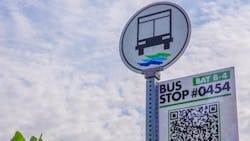Hampton Roads Transit installs smart stop bus signs at more than 2,600 locations
Hampton Roads Transit (HRT) has completed the installation of smart stop bus signs at more than 2,600 locations in six cities, enabling customers to get real-time bus information and more from a unique QR code on each sign.
The agency says that by scanning the QR code at their stop, customers with smartphones can also report bus-stop cleanliness and safety issues, see route maps and schedules, buy HRT passes and get customer alerts and other relevant interactive features. According to the agency, the technology also is available for all modes of fixed route service, including the Elizabeth River Ferry, The Tide Light Rail and Base Express service.
“HRT’s smart stops usher in a new era of convenience, innovation and mobility,” said HRT President and CEO William E. Harrell. “This innovative, location-based technology, paired with visible and reflective signage, is designed to enhance the rider experience.”
HRT notes the designs and technology were developed in-house by HRT staff, with signs installed in batches starting in October 2023 and completed by June 2025. The agency notes the changes, which require less material and maintenance, have saved it more than $600,000 since the new signs were installed.
Along with a tech upgrade, the previous bus stop signage has been redesigned to enhance aesthetics. The signs have a new visual layout with easy-to-read stop information along with a large QR code printed on the rear of every sign and unique bus stop number boldly displayed at the top of both sides of every sign. HRT notes scanning the QR code will pull up information relevant to the exact stop it is scanned at to provide route and direction information, scheduled and real-time vehicle estimated time of arrival, trip destination, customer service alerts and more.
According to the agency, the old signs included metal flags with smaller individual route blades, which constantly got bent or broken and had to be replaced. The new design features a large single aluminum panel wrapped in highly reflective anti-graffiti vinyl.
In addition, the technology enables HRT to more efficiently maintain and improve responsiveness to cleanliness and safety issues at bus stops. Crews cleaning and performing maintenance at bus stops can scan the QR codes to validate that work has been completed or to report issues that need attention. The data is now being collected and used in real time to make more informed decisions and improve the overall customer experience at HRT bus stops.
